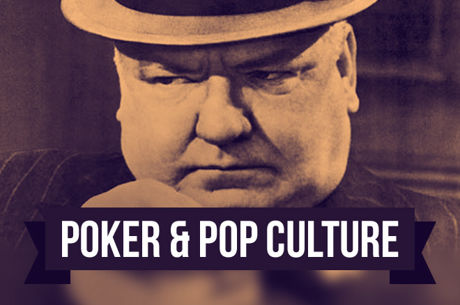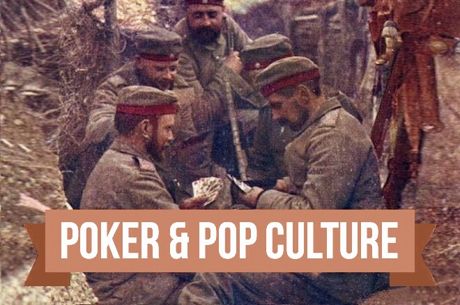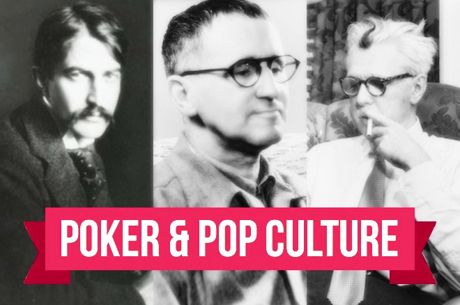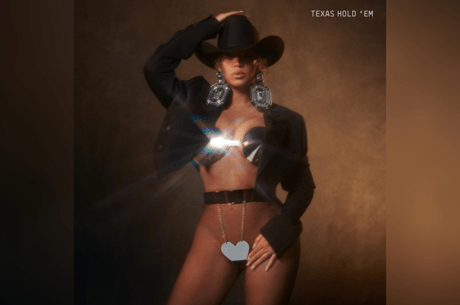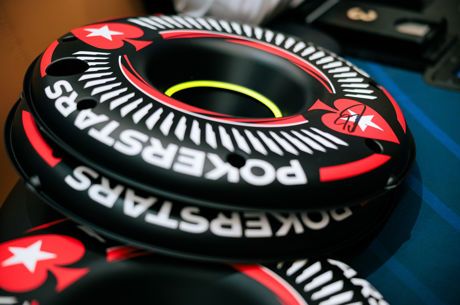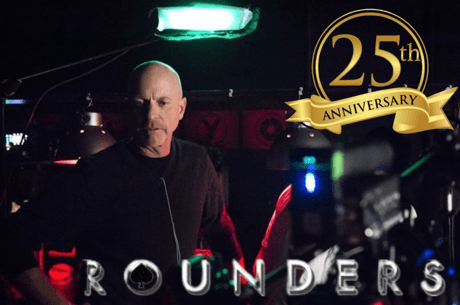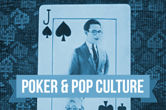Poker & Pop Culture: Play by the Book or Risk a "Dead End"
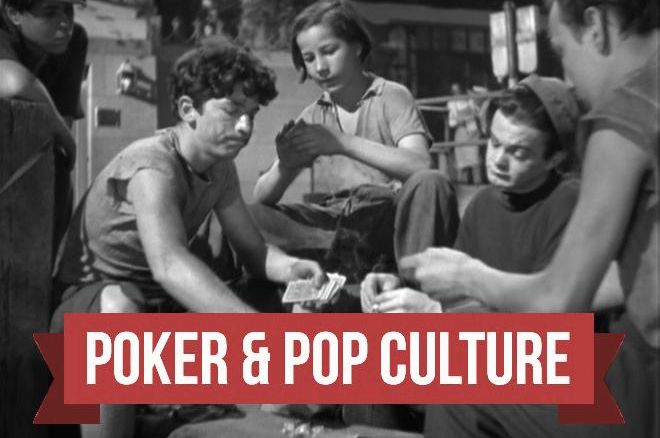
As we were noting last week, poker works in a variety of cinematic contexts, effectively helping move along plots, flesh out characters, and point up themes in a wide range of genres.
We considered one early instance of a non-poker film employing poker to good effect in Harold Lloyd's entertaining 1922 silent comedy, Dr. Jack. Another great example of poker being used in a subtle way to communicate a film��s larger themes can be found in the 1937 feature Dead End, an atmospheric crime drama with elements of film noir directed by William Wyler.
The story takes place in the slums of New York, very explicitly drawing a distinction between the upper-class families in expensive apartments and the lower-class inhabitants of the tenements upon whom they literally look down.
Based on a successful Broadway play by Sidney Kingsley and using a number of the same cast members, the film adaptation reproduces several elements of the stage production, elaborately depicting the neighborhood running up against the East River as a shadowy, ominous setting in which the ensemble cast interacts.

While there are a few subplots, there��s a primary moral set forth regarding the unsatisfactory upbringing of the children who live in the tenements, in particular one group of them, the East 53rd Place Gang �� a.k.a. the Dead End Kids �� and especially their leader, young Tommy Gordon played by Billy Halop.
This was the first of a run of seven different films over the next two years featuring the Dead End Kids, with the same six young actors appearing in each. Bogart would return for the next two (including the terrific Angels with Dirty Faces), and a young Ronald Reagan would appear in a couple as well.
As the group of actors got older they continued to star together in other films under different group names, including the "Little Tough Guys," the "East Side Kids," and most famously as the "Bowery Boys," a filmography including around 70 features. While the earlier Dead End Kids films were all dark and dramatic with the boys cast as ne��er-do-well delinquents, later incarnations of the group became more comic in tone, played primarily for laughs.
Providing context for the kids�� story in Dead End are machinations involving the adult characters, with Tommy��s older sister Drina, played by Sylvia Sidney, trying her best to provide a better life for them and save Tommy from turning from a teenaged ruffian into an adult criminal. Another figure hoping to help Tommy is Dave (Joel McCrea), a childhood friend of Drina's who grew up in the neighborhood.
Meanwhile a negative influence comes from the film��s villain, Hugh "Baby Face" Martin, portrayed by Humphrey Bogart in one of his earliest major roles. Martin also grew up in the neighborhood, turning to a life of crime which has proven lucrative for him. He��s returned in an attempt to reunite both with his mother and a former girlfriend, though is spurned by both as a murderous hoodlum.
Including Poker as "a Protest"
Rather than rehearse the entire plot, suffice it to say that while Tommy and his gang make trouble for themselves, so, too, does Baby Face Martin engage in criminal activity upon his return to his old neighborhood. The message is clear that unless Tommy changes his ways, he��ll be heading down the same destructive road taken by the gangster.
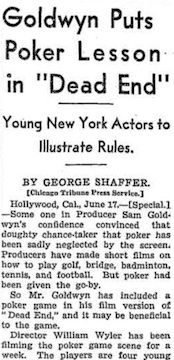
Relatively early in the film comes a short poker scene, one included in Kingsley��s play but expanded somewhat by Lillian Hellman in the screenplay. Interestingly, while Dead End was in production during the summer of 1937 there appeared an article in the The Chicago Tribune focusing on producer Samuel Goldwyn��s decision to include poker in the movie.
The article by George Shaffer notes that while several "short films on how to play golf, bridge, badminton, tennis, and football" had been screened in theaters of the day, "poker had been given the go-by." He therefore commends Goldwyn for his plan to include a poker game in Dead End, noting how "it may be very beneficial for the game" to be featured in mainstream popular culture this way.
According to Shaffer, Kingsley originally "wrote in the scene as a sort of protest against a society that lets little boys gamble and fight and swear. He wanted to show how the slum boys live in the hope that society would do something about it."
It��s obvious that the film intends to deliver such a message. It��s also interesting to consider how playing poker would be regarded as another mark against the boys and society��s failure to look after their well-being. Like spitting, using rough language, bullying and consistently failing to respect authority figures, the boys�� gambling on cards is still more evidence they are headed down a potentially troubling path.
Even the Dead End Kids Know the Right Way to Play
The game is five-card draw, being played for bottle caps. While the Tribune article describes a round of predraw betting being rehearsed during the filming, the scene opens with action being picked up during the draw.
Four of the boys are playing, their leader Tommy and new kid on the block Milty not involved.
"Gimme tree and make ��em good," begins Angel (Bobby Jordan), with Spit (Leo Gorcey) next asking for two. Next to act is Dippy (Huntz Hall), who after slamming all of his cards down calls out "five."
"For years we been telling him he can��t take five," says a disgusted Spit with a screwed-up eye. "'Five,' he keeps saying."
"Four," Dippy replies by way of correction, and again the others exhale in frustration.
"You can only take three," insists T.B. (Gabriel Dell), showing that as in most games of five-card draw, the Dead End Kids don��t allow players to draw four with an ace in the hole or simply to discard all five cards without any conditions.
"In the scene, the young players do everything according to Hoyle," commends Shaffer, who makes a lot of their playing by the book and telling Dippy he cannot draw more than three cards.

"There is no way of knowing what poker hand Mr. Kingsley intended Bobby to deal Huntz," writes Shaffer, referring to the actors by name. (In the film, Dell is actually the dealer.) "The script of the play doesn��t specify. But it really doesn��t matter."
"What does matter," Shaffer continues, "is that perhaps the lesson in draw may do some good, in that it may prevent unskilled players from demanding more than three cards."
Shaffer is right �� besides teaching viewers something about the rules of five-card draw, there��s a strategy lesson being advanced, too. That��s because drawing more than three cards is typically a losing move, much too loose to be profitable over the long term.
Dippy scratches his head while reconsidering, giving the impression that he��s actually studying his hand for the first time.
"Gimme one," he decides, and with a smirk T.B. deals him his card before taking two himself.
Take Reckless Risks, Prepare to be Punished
The hand gets interrupted during the final betting round when representatives from a rival gang arrive to challenge the Dead End Kids to a fight. Having observed the proceedings, Baby Face Martin decides to give the boys advice about how to approach their upcoming fight, encouraging them to break rules they had just established when scheduling it.
Martin tells them to use milk bottles, which Tommy points out were forbidden. The grown-up criminal is unimpressed.
"When you fight the idea is to win, it don��t matter how," he says, going on to encourage them to take knives as well (also forbidden). Before long Martin is showing Tommy how to throw a knife accurately, directly molding him into becoming the criminal he��s become.
Schaffer highlights how the poker scene teaches audiences a little bit about how to play the game while further marking the kids as ruffians. But the scene also delivers in a small, subtle way the larger moral message of the film regarding the importance of following rules.
Even these little lawbreakers understand you can��t ignore the rule about not drawing more than three cards in five-card draw, just as they initially insist to Baby Face Martin they shouldn��t break rules about the fight. But he persuades them otherwise, and in fact his influence on Tommy is such that by the latter half of the film the kid finds himself in big trouble with the law and likely headed to reform school. (Meanwhile Martin faces an even more grievous fate.)
If you play poker the wrong way �� either by not observing the rules or playing a reckless, risky strategy �� the consequences are often going to be negative. Similarly (says the film) are kids in danger of heading down a "dead end" if they aren��t taught the importance of following rules and acting right by others.
"He��s not such a bad kid," says Drina, at one point arguing the case for her younger brother Tommy to Dave. "The famous Baby Face Martin used to live on this block," Dave replies. "He wasn��t such a bad kid, either, at first. He was smart and brave and decent... at first."
But unlike Dippy who finally learned otherwise, Baby Face Martin just kept right on insisting on drawing five.
From the forthcoming "Poker & Pop Culture: Telling the Story of America's Favorite Card Game." Martin Harris teaches a course in "Poker in American Film and Culture" in the American Studies program at UNC-Charlotte.

